Halupki Stuffed Cabbage Rolls
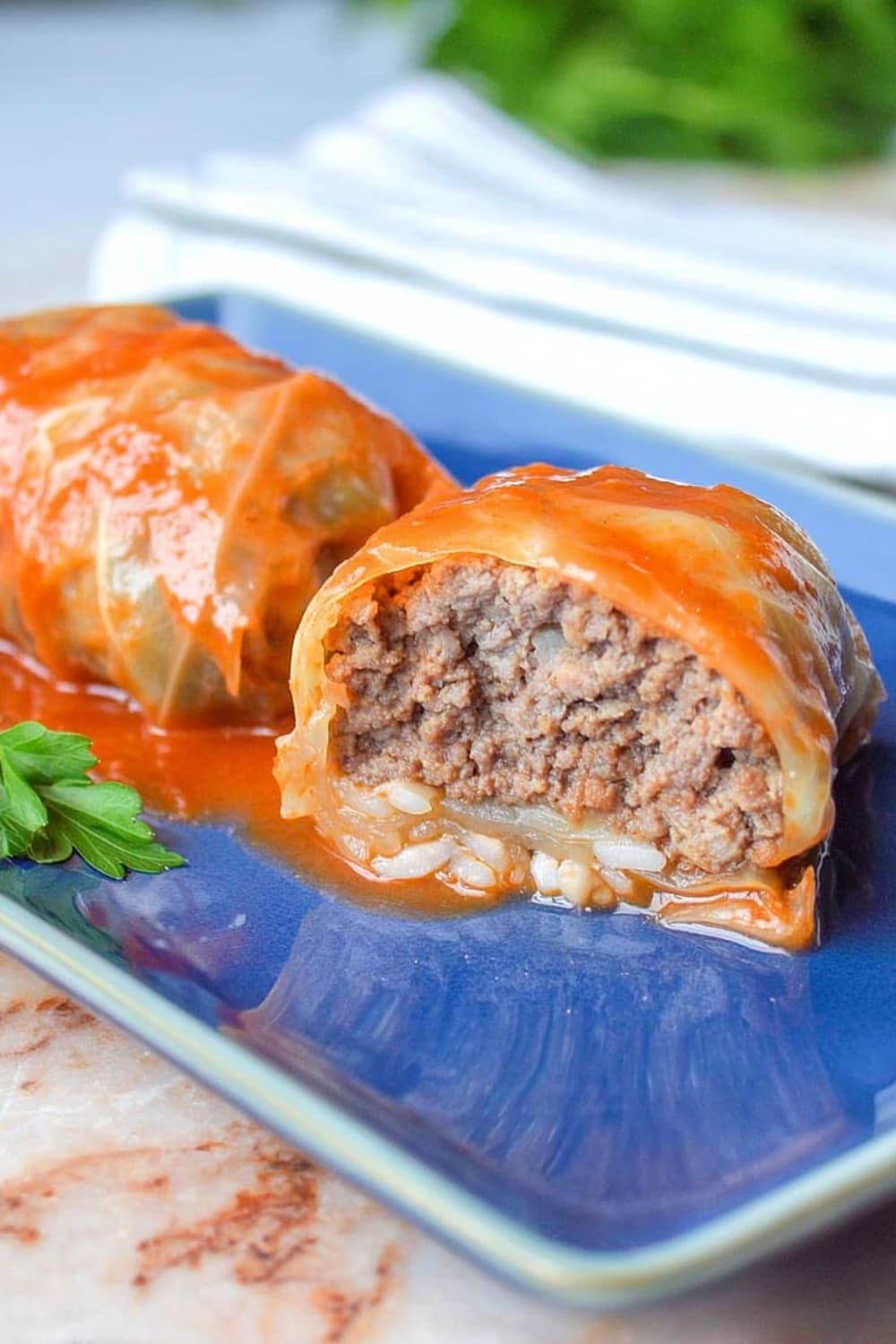
These stuffed cabbage rolls are basically comfort food wrapped in a vegetable disguise, fooling absolutely no one but making everyone happy anyway.
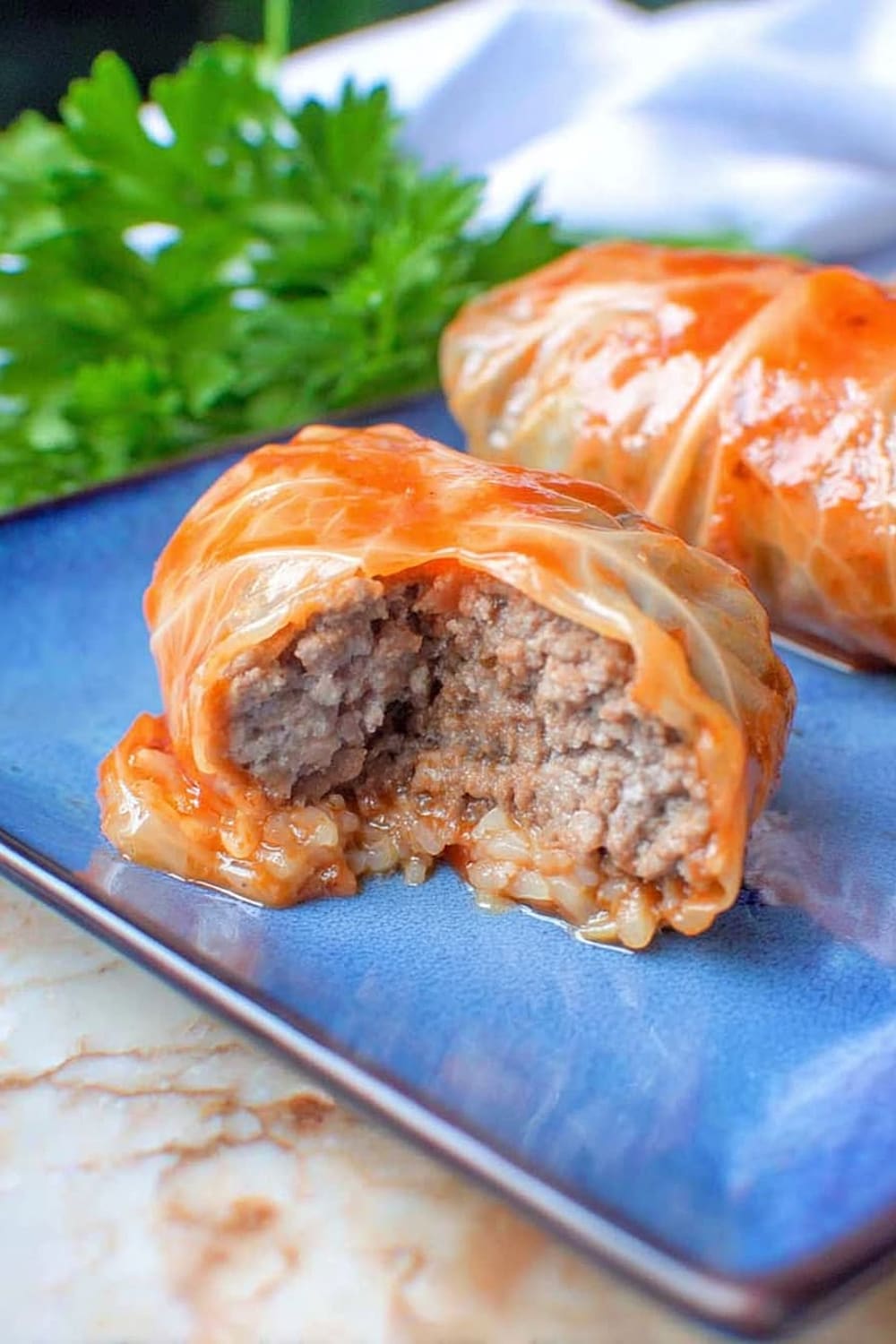
The combination of seasoned ground beef and sausage with jasmine rice creates the kind of hearty filling that makes you forget you’re technically eating your vegetables.

Each tender cabbage leaf becomes a perfect little package, swimming in rich tomato soup that transforms into the most satisfying sauce as it bakes.
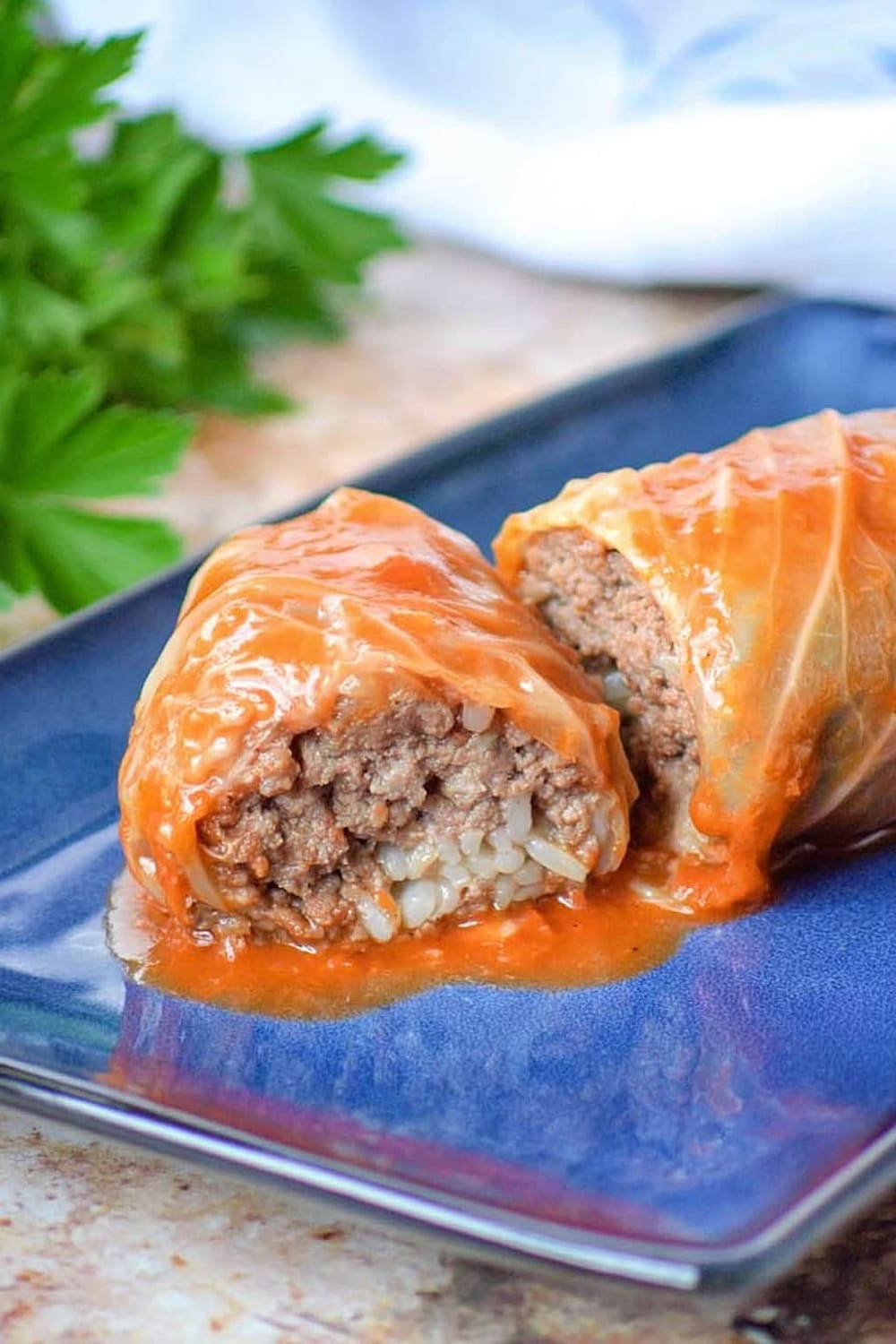
This is the recipe that turns “I don’t really like cabbage” people into “okay, maybe I like cabbage when it’s stuffed with meat and drowning in tomato goodness” people.
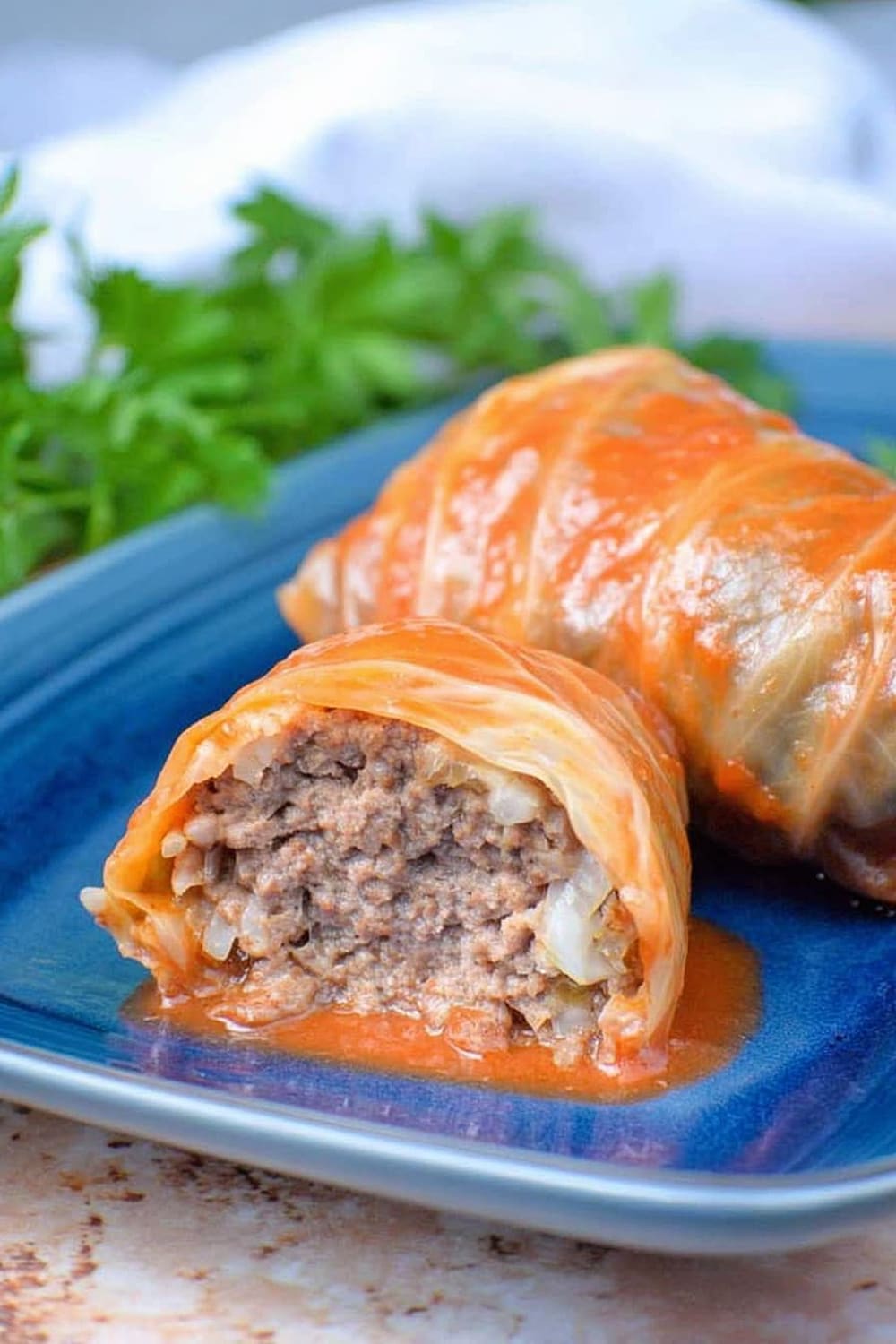
The beauty lies in how simple ingredients—cabbage, ground meat, rice, and canned soup—somehow create something that tastes like it took way more effort than it actually did.
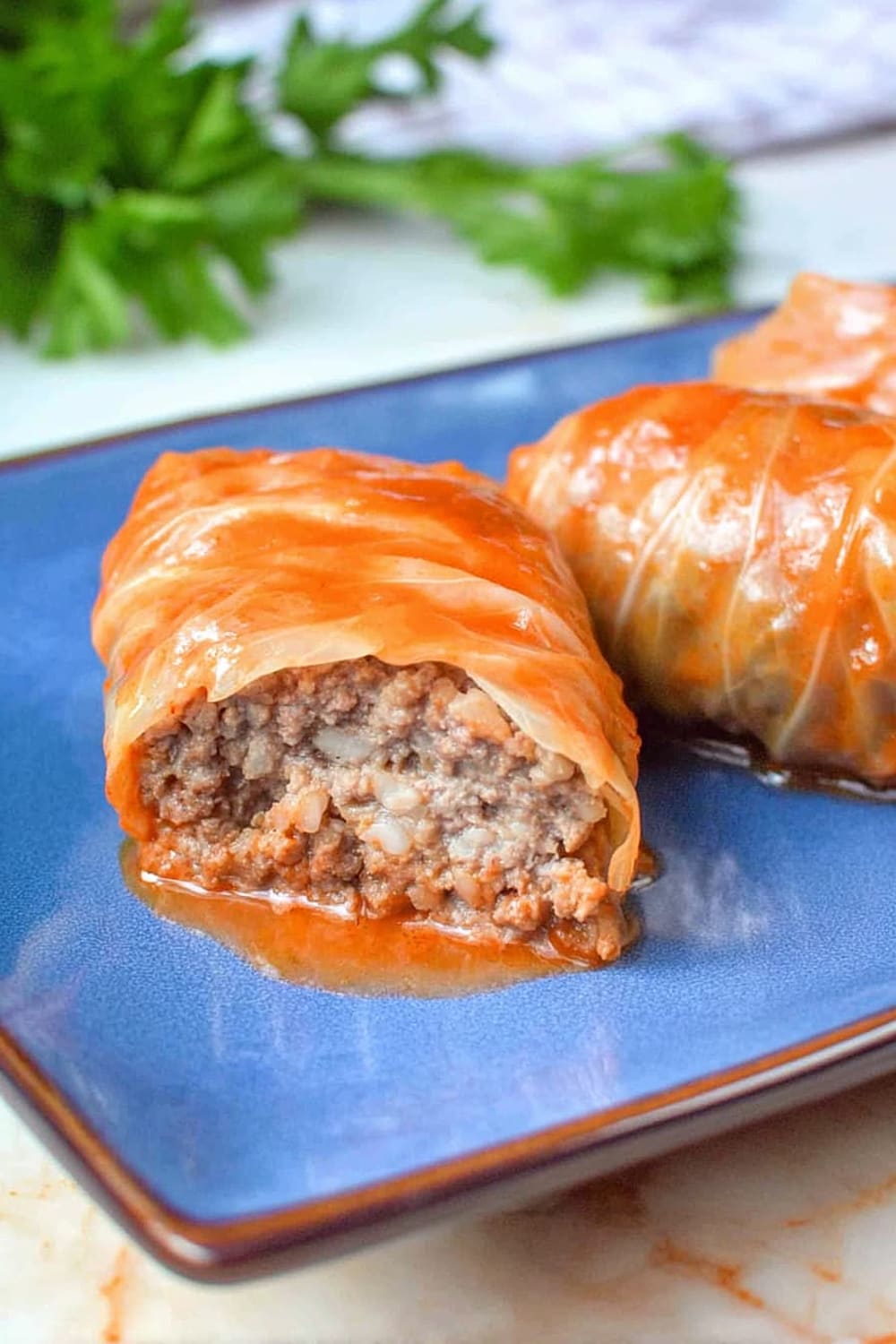
Warning: making these will result in people assuming you’re some kind of Eastern European cooking wizard, when really you just followed directions and didn’t burn anything.
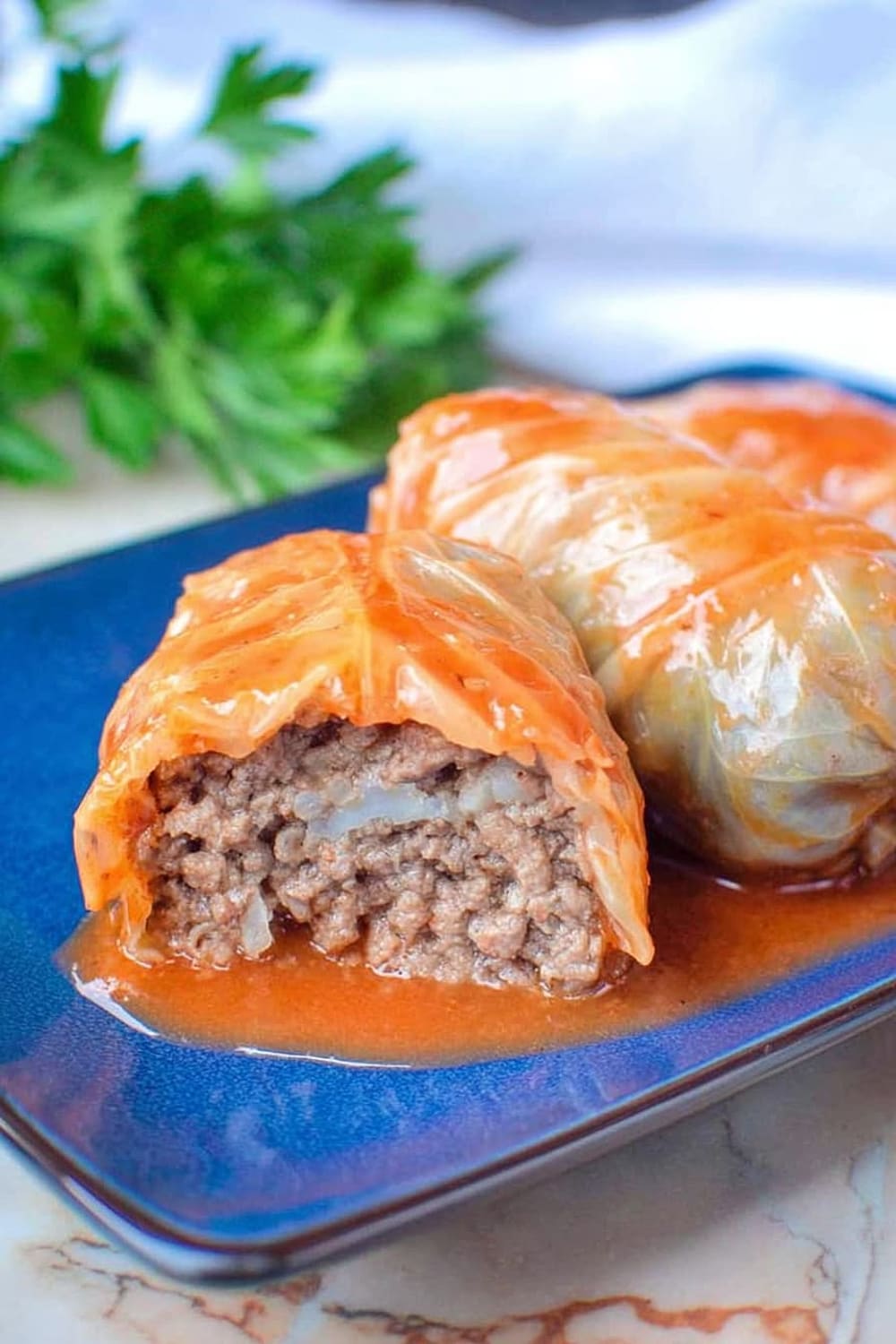
Ingredients
For the Cabbage
- 1 large head of cabbage, cored
For the Filling
- 1 lb ground beef
- 1 lb ground sausage
- 1 /4 cup minced white onion
- 2 eggs, beaten
- 1 /2 tsp garlic powder
- 3 tbsp Jane’s Crazy Mixed Up Salt
- 2 tsp pepper
- 1 cup jasmine rice, cooked according to package directions and cooled
For the Sauce
- 2 large cans tomato soup
Instructions
Prepare the Cabbage
- 1 Bring a large pot of water to a rolling boil and carefully lower the cored cabbage head into the water. Boil for 8-10 minutes until the outer leaves are soft and pliable but not falling apart—you want them flexible enough to roll but sturdy enough to hold the filling. Remove the cabbage from the water using tongs or a large slotted spoon and allow it to rest and cool on a cutting board.
Make the Filling
- 2 In a large mixing bowl, combine the ground beef, ground sausage, minced onion, beaten eggs, garlic powder, Jane’s Crazy Mixed Up Salt, pepper, and cooled jasmine rice. Using your hands just like making a good old-fashioned meatloaf, mix and knead all ingredients together until everything is completely incorporated and the mixture holds together well. The rice should be evenly distributed throughout the meat mixture.
Assemble the Rolls
- 3 Preheat your oven to 350°F (175°C). Carefully separate and pull off the cabbage leaves one at a time, avoiding tearing or ripping them—if a leaf tears, you can still use it by overlapping the torn edges. Working with one leaf at a time, place a generous scoop (about 1/3 cup) of the meat and rice mixture near the stem end of each leaf.
- 4 To roll each halupki, fold the sides of the cabbage leaf inward to create a pocket around the filling, then roll the rest of the cabbage leaf up tightly like a burrito, ensuring the seam side faces down. Set each completed roll aside as you work through the remaining leaves and filling.
Bake the Halupki
- 5 In a large casserole dish or 9×13 inch baking dish, spread one can of tomato soup evenly across the bottom to create a base layer. Nestle the completed halupki into the dish in a single layer, seam side down, ensuring they fit snugly but aren’t overcrowded.
- 6 Pour the remaining can of tomato soup evenly over the top of all the cabbage rolls, ensuring each roll gets some coverage. Cover the dish tightly with either a fitted lid or aluminum foil, creating a seal to trap steam and moisture during baking.
- 7 Bake for 40 minutes until the internal temperature of the filling reaches 160°F (71°C) and the cabbage is fork-tender. Remove the dish from the oven, uncover carefully to avoid steam burns, and let rest for 5 minutes before serving to allow the flavors to settle and the sauce to thicken slightly.
- 8 To serve, carefully ladle each halupki onto individual serving plates and spoon the rich tomato sauce from the bottom of the dish over the top just before serving.
Recommended Equipment and Kitchen Tools
Essential Tools (for best results)
- Large stockpot – Essential for boiling the whole cabbage head evenly and safely
- Digital meat thermometer – Ensures your filling reaches the safe internal temperature of 160°F
- Large mixing bowls – You’ll need substantial space for combining the meat mixture thoroughly
- 9×13 inch casserole dish – Perfect size for arranging halupki in a single layer with proper sauce coverage
Helpful Upgrades
- Kitchen tongs – Makes removing the hot cabbage from boiling water much safer than using forks or spoons
- Bench scraper – Excellent for portioning the meat mixture evenly across all the cabbage leaves
- Aluminum foil – Heavy-duty foil creates a better seal for steam retention during baking
- Silicone spatula – Ideal for spreading the tomato soup base evenly in your casserole dish
Nice-to-Have Options
Kitchen scale – For perfectly consistent portion sizes if you want restaurant-quality uniformity
Instant-read thermometer – Quicker temperature checks than a standard meat thermometer
Glass baking dish – Allows you to monitor browning and sauce bubbling during the baking process
Remember, these are suggestions to make your cooking experience smoother and more enjoyable—you can absolutely make delicious halupki with basic kitchen equipment you already own.
Recipe Variations and Dietary Modifications
Protein Variations
- Ground turkey and chicken sausage – Reduces fat content while maintaining flavor complexity
- All ground beef – Use 2 lbs ground beef (80/20 blend) for a more uniform taste
- Vegetarian version – Replace meat with 2 cups cooked lentils and 1 cup chopped mushrooms sautéed until golden
- Lamb and beef combination – Substitute 1 lb ground lamb for the sausage for Mediterranean flair
Rice and Grain Alternatives
- Cauliflower rice – Use 2 cups riced cauliflower (pre-cooked and drained) for low-carb option
- Wild rice blend – Creates nuttier texture and adds extra fiber and protein
- Quinoa substitution – Use 1 cup cooked quinoa for higher protein content and gluten-free option
- Brown rice – Increases fiber content and adds heartier texture
Sauce Modifications
- Homemade tomato sauce – Replace canned soup with 3 cups marinara plus 1/2 cup beef broth
- Creamy mushroom version – Use cream of mushroom soup instead of tomato for Eastern European variation
- Spicy kick – Add 1 tsp red pepper flakes and 1 diced jalapeño to the tomato soup base
Flavor Profile Changes
- Italian-inspired – Add 1 tsp dried oregano, 1 tsp basil, and 1/4 cup Parmesan cheese to filling
- Mediterranean style – Include 1/4 cup pine nuts, 2 tbsp dried dill, and crumbled feta cheese
Nutritional Information and Health Benefits
Key Nutritional Highlights
Each serving of halupki provides approximately 385 calories with a balanced macronutrient profile of 28g protein, 15g fat, and 32g carbohydrates. The combination of ground beef and sausage delivers high-quality complete proteins containing all essential amino acids necessary for muscle maintenance and repair. The jasmine rice contributes complex carbohydrates for sustained energy, while the cabbage adds 4g dietary fiber per serving to support digestive health.
Health Benefits of Main Ingredients
Cabbage is a nutritional powerhouse, packed with vitamin C (providing 54% of daily needs per serving), vitamin K for bone health, and powerful antioxidants called glucosinolates that support detoxification processes. The ground beef provides essential iron for oxygen transport, zinc for immune function, and B-vitamins particularly B12 for nerve health. Jasmine rice offers easily digestible carbohydrates and small amounts of thiamine and niacin for energy metabolism. The eggs in the filling contribute choline for brain health and selenium as an antioxidant.
Dietary Considerations
This recipe contains gluten (check sausage ingredients), eggs, and is dairy-free as written. Each serving provides approximately 18% of daily iron needs and 35% of daily protein requirements for average adults. The moderate sodium content comes primarily from the seasoning salt and canned soup, making portion control important for those monitoring sodium intake.
Smart Swaps and Ingredient Substitutions
Meat Substitutions:
- Ground beef → Ground turkey (use 93/7 lean, add 1 tbsp olive oil for moisture)
- Ground sausage → Italian turkey sausage or chicken sausage (maintain 1 lb quantity)
- Both meats → 2 lbs ground chicken (season with 1 tsp fennel seeds and 1 tsp paprika)
Seasoning Alternatives:
- Jane’s Crazy Mixed Up Salt → 2 tbsp regular salt + 1 tbsp garlic powder + 1 tsp onion powder
- Fresh garlic → 3 cloves minced fresh garlic instead of garlic powder
- White onion → Yellow onion or shallots (same quantity)
Rice Substitutions:
- Jasmine rice → Long-grain white rice or basmati rice (cook according to package directions)
- Cauliflower rice → Use 2 cups, sauté until tender and drain excess moisture
- Quinoa → 3/4 cup cooked quinoa (less absorbent than rice)
Soup Base Alternatives:
- Tomato soup → 1 can crushed tomatoes + 1 can tomato sauce + 1 tbsp sugar
- Low-sodium option → No-salt-added tomato soup plus seasonings to taste
- Creamy version → Cream of mushroom soup for traditional Polish variation
Budget-Friendly Swaps:
- Ground sausage → Ground beef + 1 tsp Italian seasoning + 1/2 tsp red pepper flakes
- Fresh onion → 2 tbsp onion powder (rehydrate in 2 tbsp water)
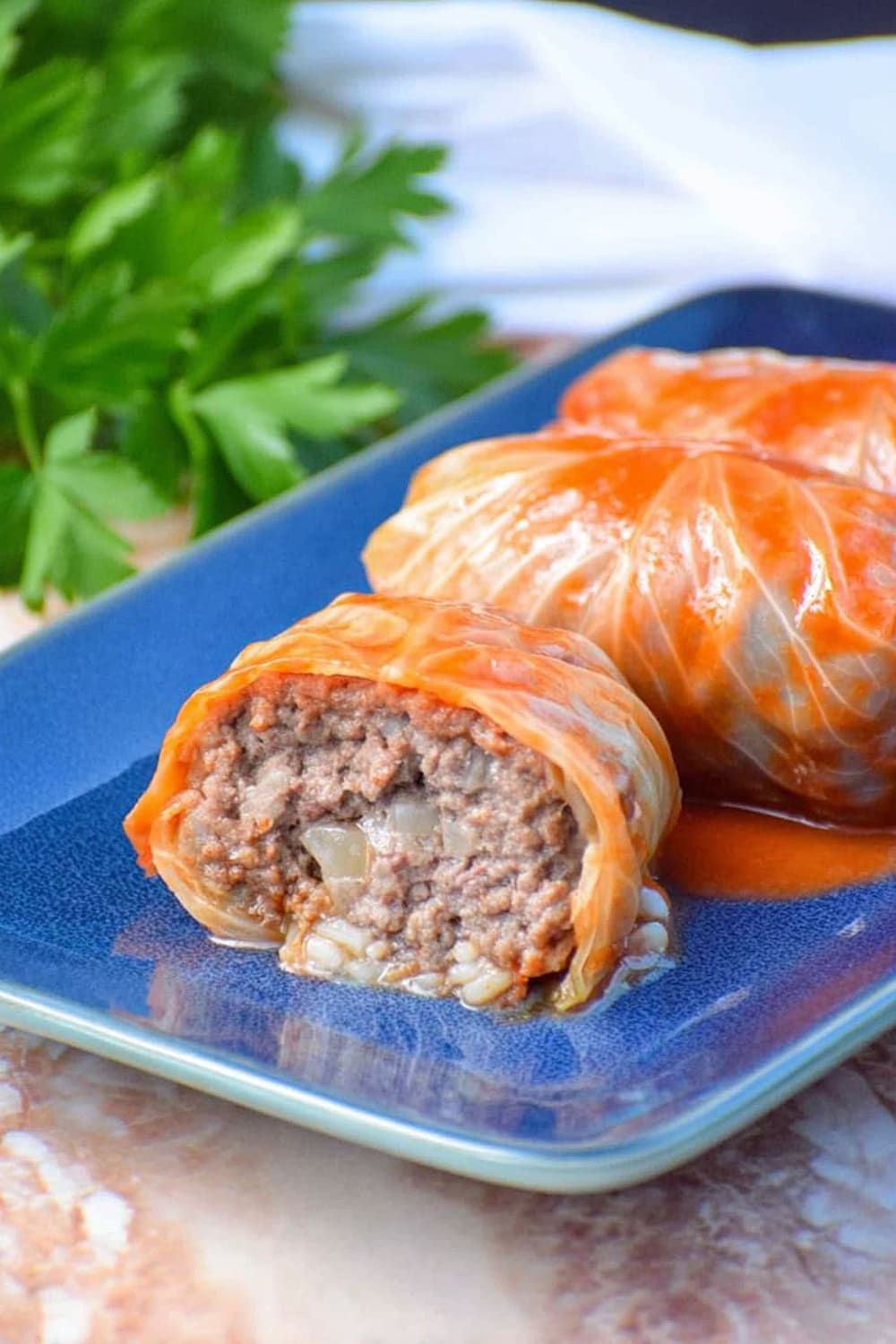
Make It Diabetes-Friendly
Carbohydrate Modifications:
- Replace jasmine rice → 1 1/2 cups riced cauliflower (reduces carbs from 32g to 18g per serving)
- Reduce rice portion → 1/2 cup cooked rice instead of full cup (saves 15g carbs per serving)
- Add fiber → 1/4 cup ground flaxseed to meat mixture (increases fiber, reduces net carbs)
Sugar-Conscious Soup Swaps:
- Regular tomato soup → No-sugar-added tomato soup (reduces 8g sugar per serving)
- Homemade sauce → 2 cups crushed tomatoes + 1 cup low-sodium broth (eliminates added sugars)
- Fresh tomato base → 3 cups diced fresh tomatoes + herbs (lowest sugar option)
Protein Enhancement:
- Increase protein ratio → 1.5 lbs meat + 0.5 cups rice instead of 2 lbs meat + 1 cup rice
- Add extra eggs → 3 eggs instead of 2 for better satiety and blood sugar stability
- Lean meat focus → Use 90/10 ground beef to reduce saturated fat
Portion & Timing Strategies:
- Optimal serving size → 1-2 rolls per meal (approximately 20-25g carbs)
- Pair with protein → Side of Greek yogurt or small salad with nuts
- Meal timing → Serve at lunch when insulin sensitivity is typically higher
Total Carb Reduction: Modified version contains approximately 18-22g carbs per serving versus 32g in original recipe.
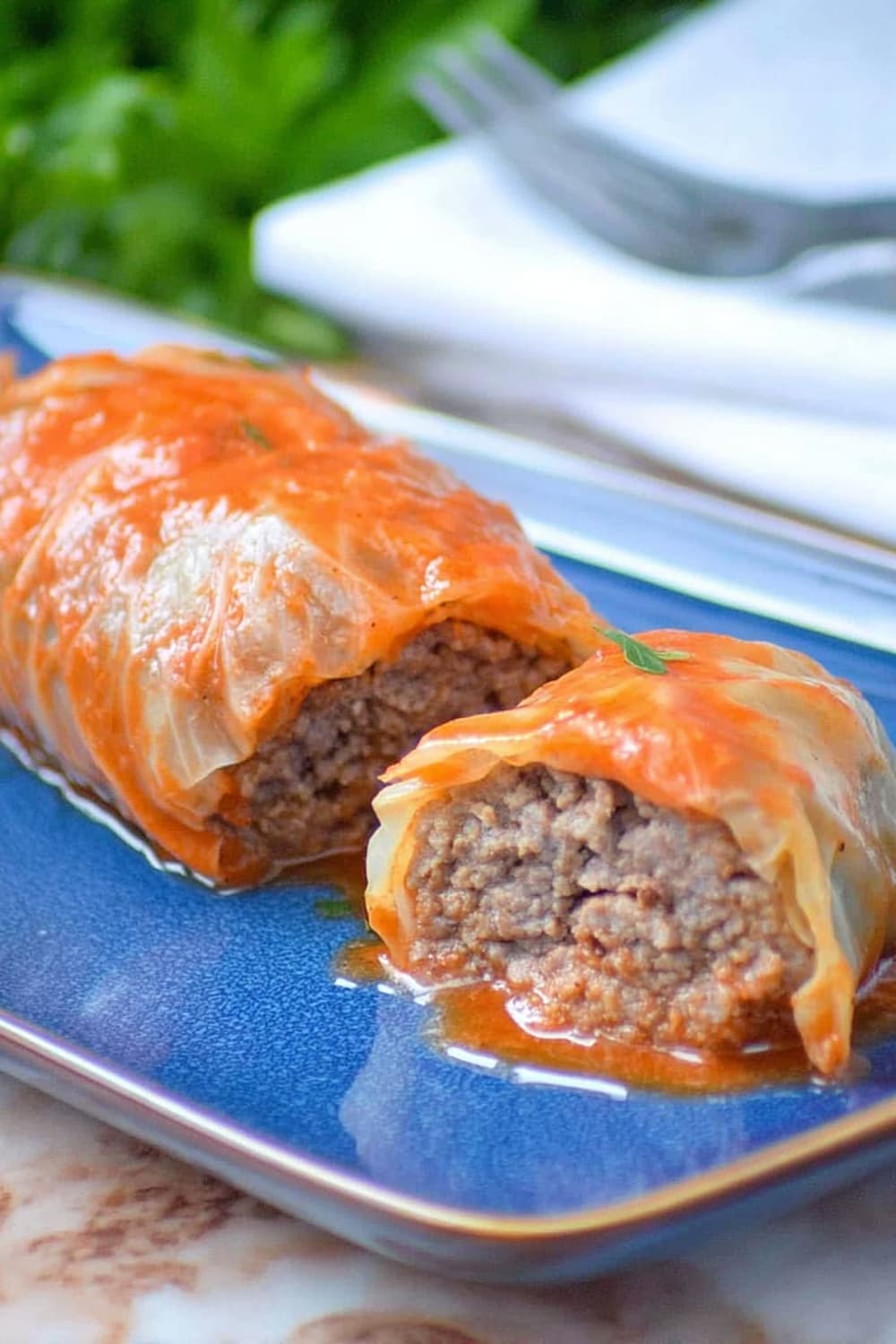
Perfect Pairing Suggestions
Beverage Pairings
A medium-bodied red wine like Merlot or Cabernet Sauvignon complements the rich meat filling beautifully, while the acidity cuts through the tomato sauce. For beer lovers, a Czech pilsner or German lager provides the perfect crisp contrast to the hearty, comfort-food nature of halupki. Non-alcoholic options include sparkling apple cider or cranberry juice with soda water for festive occasions, or simply iced tea with lemon for everyday meals.
Side Dish Recommendations
Roasted root vegetables like carrots, parsnips, and potatoes echo the Eastern European theme while adding colorful nutrition to your plate. A simple cucumber salad with dill and vinegar provides refreshing acidity that balances the rich tomato sauce. Crusty rye bread or dinner rolls are perfect for soaking up every drop of that delicious tomato sauce. For lighter options, consider steamed green beans with almonds or a mixed greens salad with balsamic vinaigrette.
Complete Meal Ideas
Start with Polish pickle soup or simple beet salad as appetizers that honor the recipe’s heritage. Follow the halupki with apple strudel or poppyseed cake for an authentic Eastern European feast. For casual family dinners, pair with mashed potatoes and buttered corn for ultimate comfort food satisfaction.
Occasion Suggestions
These halupki shine at Sunday family dinners, potluck gatherings, and holiday celebrations where comfort food is welcome. They’re perfect for meal prep since they reheat beautifully, and impressive enough for entertaining when you want to serve something unique but approachable.
Pro Tips and Troubleshooting
Professional Techniques
Blanch cabbage leaves individually if your pot isn’t large enough for the whole head—this gives you more control over texture. Chill the cooked rice completely before mixing with meat to prevent the eggs from cooking prematurely and creating a gummy texture. Score the thick stem of each cabbage leaf with a knife to make rolling easier without breaking the leaf. Test your first roll by cutting it in half after baking to check doneness and adjust timing for remaining batches.
Common Mistake Prevention
Don’t overstuff the cabbage leaves—too much filling makes them difficult to roll and prone to bursting during baking. Avoid using hot rice in the meat mixture as it will partially cook the eggs and create an unpleasant texture. Never skip the resting period after baking—the rolls need time for the filling to set and the sauce to thicken properly.
Storage and Reheating
Refrigerate leftovers for up to 4 days in the original baking dish covered tightly. Reheat in the oven at 325°F (163°C) for 15-20 minutes rather than microwaving to maintain texture. Freeze assembled but unbaked halupki for up to 3 months—add 10 extra minutes to baking time when cooking from frozen.
Make-Ahead Strategies
Assemble completely up to 24 hours ahead and refrigerate covered—this actually improves flavor as seasonings meld. Cook rice the day before and refrigerate for easier handling and better texture in the final dish.
Whether you’re honoring family traditions or discovering this comfort food classic for the first time, these halupki deliver all the satisfaction of a home-cooked meal that tastes like it took way more effort than it actually did. The tender cabbage wrapping, savory meat and rice filling, and rich tomato sauce create the kind of dinner that makes everyone at the table happy and asking for seconds.